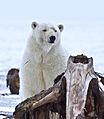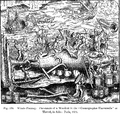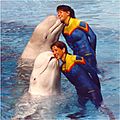Whale facts for kids
Quick facts for kids Whale
An informal group
within the infraorder Cetacea |
|
|---|---|
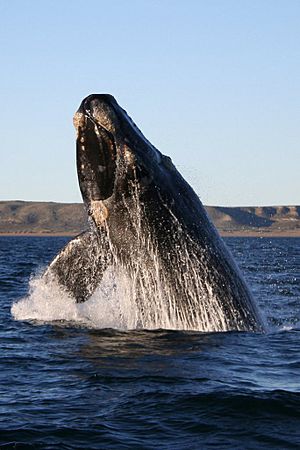 |
|
| Ssouthern right whale | |
| Scientific classification | |
| Kingdom: | Animalia |
| Phylum: | Chordata |
| Class: | Mammalia |
| Order: | Artiodactyla |
| Suborder: | Whippomorpha |
| Infraorder: | Cetacea |
| Groups included | |
|
|
| Cladistically included but traditionally excluded taxa | |
|
|
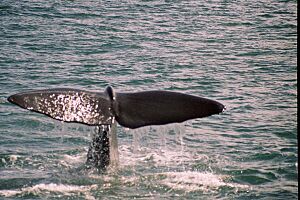
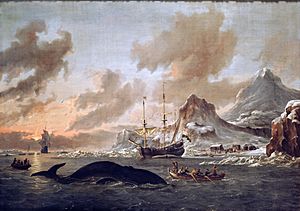
Whales are very large ocean mammals. They live in the sea but breathe oxygen from the air. Like other mammals, they are warm-blooded and have a little bit of hair.
There are about 100 different species of whales. They are split into two main groups. Sometimes, people use the word "whale" for all Cetaceans. This group includes dolphins and porpoises. Other times, people only call the very large ones "whales." There is no clear rule for telling whales and dolphins apart.
In the past, people hunted whales for their meat and oil. This was done by whalers. Today, many countries have laws to protect whales. These laws stop people from hunting whales. However, some countries, like Iceland and Japan, still allow whaling. In other places, like the USA, only certain groups, such as Eskimos, can hunt whales like the blue whale or beluga whale.
Contents
What Do Whales Eat?
Whales eat different things depending on their type.
Baleen Whales: Filter Feeders
Baleen whales eat tiny sea creatures. These include plankton and krill. Plankton are like clouds of very small fish and plants floating in the water.
Baleen whales have huge mouths. They open their mouths wide to take in a lot of seawater. Their throats can stretch to make more space. Then, they close their mouths and push the water out. Their food stays inside because they do not have teeth. Instead, they have filters called baleen. Baleen are long, hard strips that work like a strainer. The water goes through the baleen. But the small animals and plants are trapped. The whale then swallows them. This is very different from how toothed whales eat.
Toothed Whales: Hunters of the Sea
Toothed whales eat bigger fish or other animals. They are like very large dolphins. They have sharp teeth and often a big forehead. Inside their forehead is a special area. This area helps them make and direct sounds.
Toothed whales make many kinds of sounds. Some sounds are so loud they can shock fish. They also use echolocation to find things they cannot see. Echolocation is like using sound waves to create a picture of their surroundings. Some toothed whales, like the sperm whale, are always called whales. Others are sometimes called dolphins.
Whale Families
Scientists group whales and their relatives into two main types. These groups are called suborders.
Baleen Whales (Mysticeti)
The largest group is called Mysticeti. These are the baleen whales. They have baleen plates in their upper jaw. Baleen is made of keratin, which is like your fingernails. They use this sieve-like structure to filter tiny food from the water.
Toothed Whales (Odontoceti)
The other group is called Odontoceti. These are the toothed whales. They have sharp teeth for hunting their food. This group also includes dolphins and porpoises.
Whales, dolphins, and porpoises are all part of a larger group. This group is called Cetartiodactyla. It also includes hippopotamuses. Scientists believe that whales are the closest living relatives of hippos.
How Whales Evolved
All whales, dolphins, and porpoises came from land mammals. These were animals with hooves, like deer. They are related to an extinct animal called Indohyus. This animal looked like a deer and lived partly in water. Whales split from this group about 54 million years ago.
The first whales probably started living in the sea about 50 million years ago. They became fully ocean animals about 5 to 10 million years later. A fossil called Pakicetus is important. It shows how whales changed from land to sea.
Scientists have studied many animals that dive and hold their breath. They found that larger animals can hold their breath longer. This is because they can store more oxygen. This difference was much bigger for warm-blooded animals. This might be why modern whales became so large.
How Whales Live
Whales are different from many animals because they decide when to breathe. They are "conscious breathers." They breathe through holes on top of their heads called blowholes. Baleen whales have two blowholes. Toothed whales have one. This lets them breathe while most of their body is underwater. When they breathe out, extra water shoots out of the blowhole. This makes a jet of water and air. Then they breathe air into their lungs.
Whale Sleep
All mammals need to sleep, including whales. But whales cannot be completely unconscious for too long. They need to be awake enough to breathe. Scientists think that only one side of their brain sleeps at a time. This means whales are never fully asleep. But they still get the rest they need. Whales are thought to sleep about eight hours a day.
Life Cycle and Baby Whales
A baby whale is called a "calf." A mother whale usually has one calf every two or three years. The calf grows inside the mother for up to a year. Baby whales drink their mother's milk for more than a year. There is a very strong bond between a mother and her calf. Whales become old enough to have babies themselves when they are about seven to ten years old.
Whales have few babies, but these babies have a good chance of surviving. Because they have babies slowly, hunting has a big effect on whale numbers. It takes a long time for their populations to grow back.
Whale Behavior
Whales do many interesting things. They communicate, play, and interact with each other.
How Whales Communicate
Some whales, like the humpback whale, make beautiful, melodic sounds. These are known as whale song. These sounds can be very loud. Toothed whales use sonar. This is like a natural radar system. They can make sounds up to 20,000 watts. These sounds can be heard for many miles.
Whales in aquariums have sometimes copied human speech. Scientists think this shows that whales really want to talk to humans. It takes a lot of effort for whales to make human sounds. This is because their vocal system is very different from ours.
Whales make two main types of sounds. These are called whistles and clicks.
How Whales Socialize
Whales are known to teach each other. They also learn, work together, and even show sadness.
Smaller whales enjoy playing complex games. They can make stable underwater air rings, called "bubble rings." They also seem to like biting these rings. This makes them burst into many separate bubbles. Then the bubbles quickly rise to the surface. Some people think this is a way for them to communicate. Whales also make "bubble-nets" to help them catch food.

Larger whales also play. For example, the southern right whale lifts its tail fluke high above the water. It stays in this position for a long time. This is called "sailing." It seems to be a form of play. It is often seen off the coasts of Argentina and South Africa. Humpback whales also do this.
Breaching and Other Surface Behaviors
Breaching is when a whale jumps high into the air. Then it purposefully flops back down onto the water. This makes a huge splash. Sometimes, the whale spins in the air while it jumps. Scientists are not sure why whales breach. It might be for play, to clean their skin, or to send a message to other whales.
Whales do other things on the surface that scientists don't fully understand.
- Logging: This is when a whale swims slowly at the ocean's surface. It moves very little. When a whale does this, it looks like a log floating in the water. Some scientists think this is how whales rest or sleep.
- Spyhopping: This is when a whale sits straight up in the water. Its head is out of the water. It might turn in circles while spyhopping. Scientists think whales might do this to look at what is happening above the water.
- Lobtailing: This is when a whale faces downward in the water. Then it slaps the water with its tail. This makes a very loud, thunder-like sound. Scientists think this might be a warning to other whales about danger. It could also be a way to help them find food.
Related pages
Images for kids
-
Basilosaurus skeleton
-
Features of a blue whale
-
Skeleton of a bowhead whale; notice the hind limb. Richard Lydekker, 1894
-
Biosonar by cetaceans
-
Polar bear with the remains of a beluga
-
Whale watching off Bar Harbour, Maine
-
Illustration by Gustave Doré of Baron Munchausen's tale of being swallowed by a whale. While the Biblical Book of Jonah refers to the Prophet Jonah being swallowed by "a big fish", in later derivations that "fish" was identified as a whale.
-
Beluga whales and trainers in an aquarium
See also
 In Spanish: Balénidos para niños
In Spanish: Balénidos para niños





